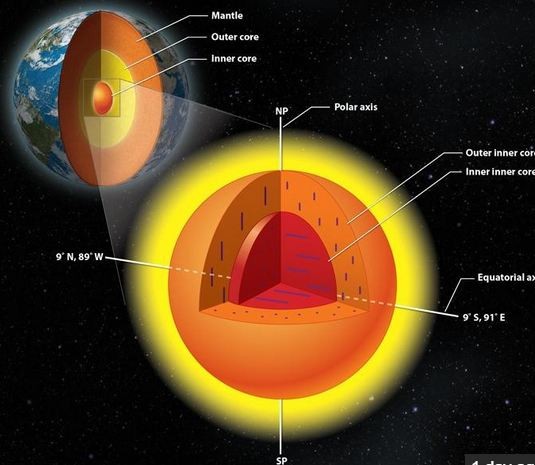The accepted scientific wisdom is that the Earth's inner core 5,000 miles below the surface consists mostly of an iron-nickel alloy.
A recent study by American and Chinese researchers, however, claims there isn't just one inner core but two inner cores. In other words, the inner core has an inner core.
A research team from the University of Illinois at Urbana-Champaign and colleagues in China found this "inner, inner core" has crystals aligned in a different direction. This finding suggests the Earth's magnetic field could have undergone a change about half a billion years ago, switching between the equatorial axes and the polar axis.
The research team believes the structure of the iron crystals in the inner, inner core is different from those found in the outer part of the inner core. Its findings were reported in the journal Nature Geoscience.
Prof. Xiaodong Song from the University of Illinois said a reason for their theory is that seismic waves are bouncing back and forth from one side of the Earth to the other side of the Earth. Researchers use seismic waves from earthquakes to scan below the Earth's surface, said Phys.org.
"Even though the inner core is small -- smaller than the moon -- it has some really interesting features," said Song as quoted in Science Daily.
"It may tell us about how our planet formed, its history, and other dynamic processes of the Earth. It shapes our understanding of what's going on deep inside the Earth."
He and his colleagues in China said this data suggests the Earth's inner core consists of two parts. One part is composed of crystals in the "inner inner core" aligned in an east-to-west direction, or flipped on its side if you're looking down at the core from the North Pole.
The other part is an "outer inner core" lined up north to south, or aligned vertically if you're looking down at the core from the North Pole.
Song said the discovery of different structures at different regions of the inner core tell scientists something about the very long history of the Earth. It suggests these structures formed under different conditions and that the Earth might have undergone a dramatic change over time.
"People have noticed differences in the way seismic waves travel through the outer parts of the inner core and its innermost reaches before, but never before have they suggested that the alignment of crystalline iron that makes up this region is completely askew compared to the outermost parts," said Prof. Simon Redfern from the University of Cambridge.
"If this is true, it would imply that something very substantial happened to flip the orientation of the core to turn the alignment of crystals in the inner core north-south as is seen today in its outer parts," Redgern added.



























